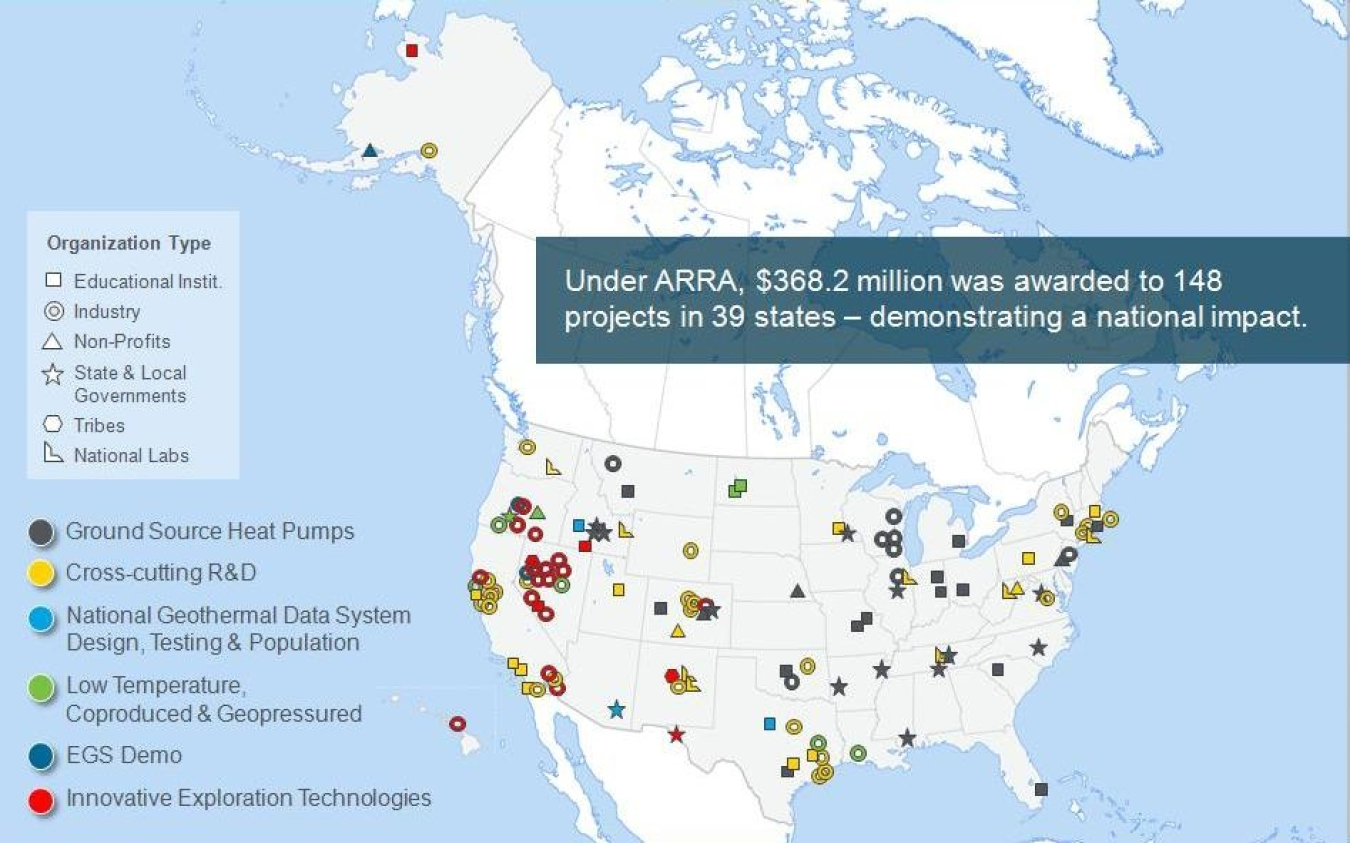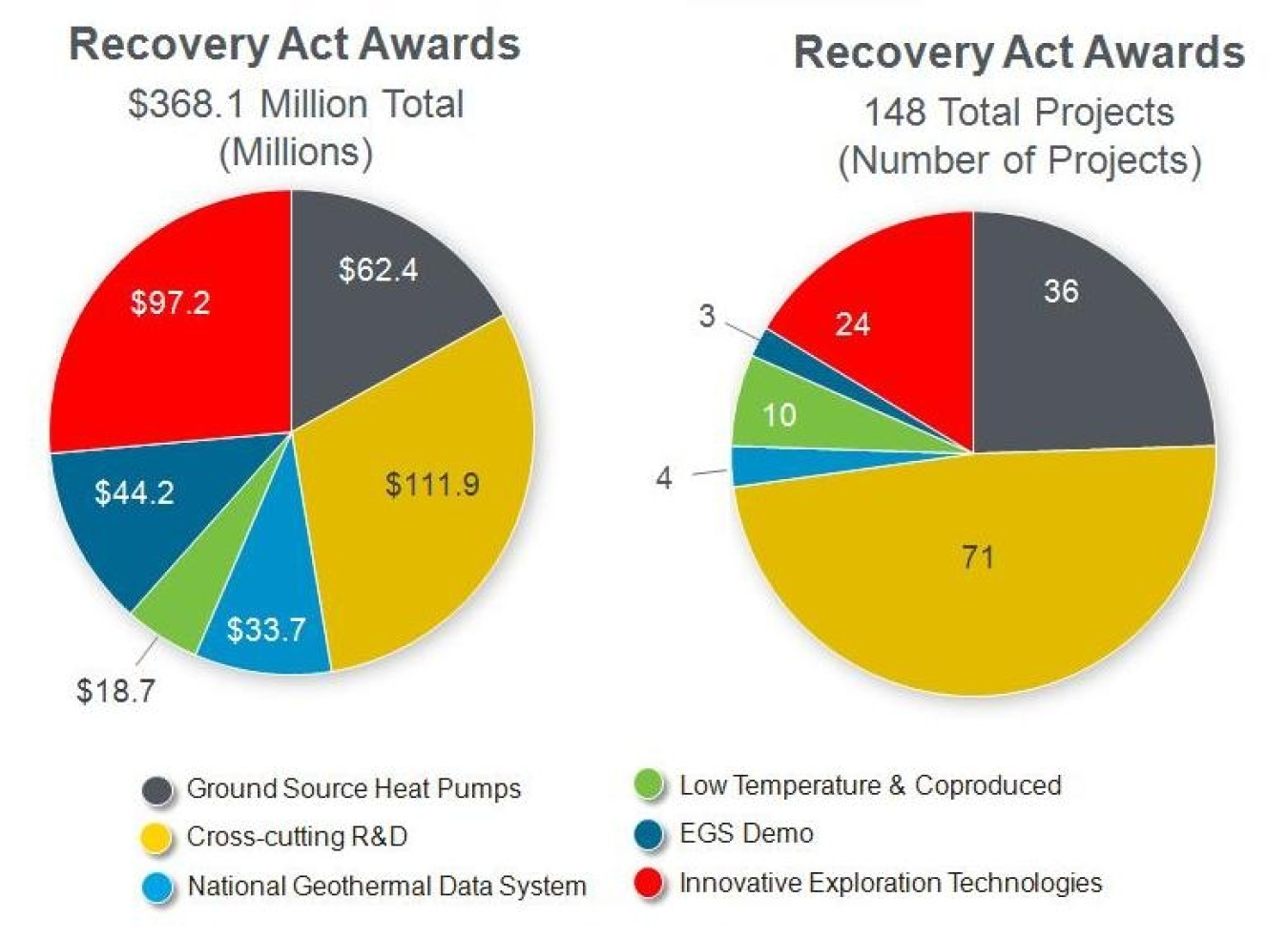The Geothermal Technologies Office (GTO) received $368.2 million through the American Recovery and Reinvestment Act (ARRA) of 2009. GTO awarded funding for projects based on their potential to advance geothermal technology, reduce costs and barriers to market entry, and foster economic growth by creating jobs.
The 148 selected awards spanned dozens of states and the District of Columbia. The advancements made by these projects created a diverse portfolio of technologies that maximized investment in geothermal energy across the spectrum of geothermal resources.

A map of the United States shows where $368.2 million was awarded to educational institutions, industry, non-profits, state and local governments, tribes, and national labs spanned across 39 states to support 148 projects in ground source heat pumps; cross-cutting research and development; national geothermal design, testing, and population; low temperature, coproduced, and geopressured; EGS demo; and innovative exploration technologies.
Snapshot of ARRA Projects by Funding and Topic Area

The American Recovery Act awarded $368.1 million to 148 geothermal-related projects including $111.9 million (71 projects) to cross-cutting research and development, $97.2 million (24 projects) to innovative exploration technologies, $62.4 million (36 projects) to ground source heat pumps, $44.2 million (3 projects) to EGS demo, $33.7 million (4 projects) to national geothermal data system, and $18.7 million (10 projects) to low temperature and coproduced resources.
Cross-Cutting Research and Development (R&D)
Projects in the cross-cutting topic area supported enhanced geothermal systems (EGS) component R&D and field demonstrations aimed at improving technologies required for EGS reservoir creation, geothermal characterization, and long-term sustainability. Forty-five projects received awards in this topic area, totaling $111.9 million in investments (U.S. Department of Energy (DOE) and industry cost share). An additional 26 projects totaling $23.7 million received awards in May 2009 through an EGS Technology R&D Laboratory Call, open only to DOE’s national laboratories. These 71 projects encompassed 19 technology areas identified through two international workshops and collaboration with DOE's Office of Science. Learn more about GTO’s current work to advance EGS.
Innovative Exploration Technologies
The Innovative Exploration Technologies (IET) initiative reduced the upfront risks and costs associated with geothermal projects, developed new, innovative exploration methods, and confirmed new geothermal capacity. DOE and industry cost share investments in IET totaled $97.2 million across 24 projects, detailed in the peer review presentations for this initiative.
Ground-Source Heat Pumps
GTO selected projects totaling $62.4 million in total funding (DOE and industry cost share) for R&D in ground-source heat pumps (GSHP), also known as geothermal heat pumps (GHPs). These projects aimed to demonstrated that large-scale applications and innovative financing help reduce installed costs for GSHPs/GHPs. Learn more about geothermal heat pumps.
Enhanced Geothermal Systems (EGS) Demonstrations
Three EGS demonstration projects, totaling $44.2 million (DOE and industry cost share) demonstrated the technical feasibility of EGS technologies in different geologic conditions and helped overcome technical barriers such as the ability to validate stimulation techniques that successfully sustain the reservoir over an extended time period. GTO fed knowledge gained from these demonstration projects into its ongoing EGS R&D. Learn more about GTO-funded EGS demonstration projects and GTO’s EGS Pilot Demonstrations funding opportunity.
National Geothermal Data System
GTO selected four projects to receive $33.7 million for work focused on collecting, cataloguing, and linking information to the National Geothermal Data System, which was developed through a separate ARRA award. In this topic area, projects focused on increasing the availability of data to the public and industry thereby reducing upfront costs and risk associated with geothermal exploration. Learn more about GTO’s data, modeling, and analysis program.
Low-Temperature and Co-produced
Projects targeting low-temperature, co-produced, and geopressured geothermal resources received a total of $18.7 million in funding (DOE and industry cost share). Low-temperature resources are defined as having a geo-fluid temperature of less than 300°F. Among other work, projects in this area assessed opportunities to take advantage of wastewater expelled from oil and gas production wells and other sources of low-to-moderate temperature fluids. Learn more about GTO’s work in low-temperature and coproduced resources program.

